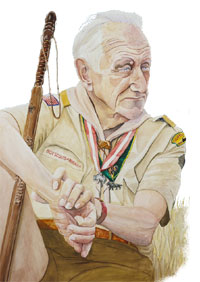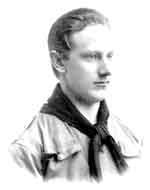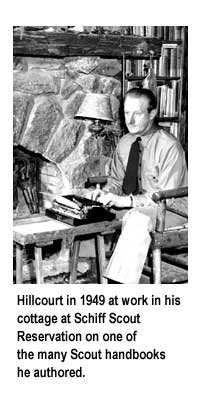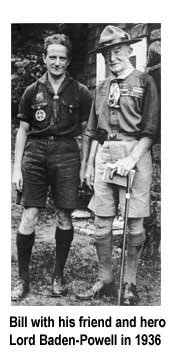-
 Scoutmaster to the World
Scoutmaster to the World
William "Green Bar Bill" Hillcourt was the distinctive Voice of Scouting for most of the Movement's history. His impact on the program of Scouting is comparable only to the Founder, Baden-Powell.
August 6, 1900 to November 9, 1992: Hillcourt was the primary inspiration for SCOUTER, and it is in his spirit that our grassroots resources are shared. We celebrate the life of Scouting's great hero and our dear old friend.
Few men can hope to impact the world as William Hillcourt did. An immigrant to the United States from Denmark in 1926, Bill became a major factor in the growth and development of the Boy Scouts of America. His handbooks and BOYS LIFE articles defined the Scout movement for millions of boys spanning decades. His Boy Scout Handbooks have been published in copies by the millions and translated into dozens of languages throughout the world; it has been estimated that those Scout Handbooks were only out numbered by Dr. Spock’s Baby Book and the Bible in total circulation. He worked with every Chief Scout Executive since James West, was the first Deputy Camp Chief for American Wood Badge, introduced the patrol method to the B.S.A., authored the definitive biography of his close friend Baden-Powell and more than thirty other books on Scouting and the outdoors. Bill Hillcourt loved and lived Scouting through the very end of his life; a life that, even at 92 years, ended surprisingly and too soon while on a worldwide tour in the name of Scouting.
-
Hillcourt: Scoutmaster to the World
 In the beginning there was Lord Baden-Powell, the hero of the siege of Mafeking in the Boer War. He wrote Scouting for Boys and started the Boy Scout movement in Britain.
In the beginning there was Lord Baden-Powell, the hero of the siege of Mafeking in the Boer War. He wrote Scouting for Boys and started the Boy Scout movement in Britain.
And there was Ernest Thompson Seton, who wrote stories about wildlife, designed woodcraft games for boys, and was the chief scout in the what was shaping up to be an American Scouting movement. And there was William Boyce, who was so impressed by an unknown English Scout who helped him find his way on a foggy night in London, and then refused a tip, that he decided to bring Scouting to America. And Daniel Carter Beard, first Scout commissioner. And James D. West, first Chief Scout Executive of the Boy Scouts of America.
And there was a young Dane, in his twenties, floating around the fledgling BSA program, right in the mix of all of these other men. He was head strong and sure of himself. He was one of the first boys in the world to have experienced Baden-Powell's new movement, and was about to become one of the greatest contributors to the development of youth in modem history.
Bill Hillcourt became the hero of millions of boys and adults. He introduced the patrol method to America, wrote more than thirty books on Scouting and the outdoors, and played the most prominent role in developing the program of Scouting for decades. Many people could tell the story of William Hillcourt. Perhaps, given his prolific literary contributions to the organization, it is most appropriate that he be remembered with his own words. Below is an autobiographical sketch, prepared by Bill before his death in November, 1992.
The Life of a Serendipitist
By William HillcourtDid you ever hear the story of the King of Serendip? He had three sons. He was proud of them and saw to it that they had the very best upbringing. He brought in the finest swordsmen and athletes of his kingdom to coach them in all the fitness skills of a true knight. He had the wisest men of the country teach them about the world and its wonders. He himself taught them kingship: how to rule with compassion and fairness.
He loved his three sons equally well. But as he grew old, he wondered which of them would make the best king when his own days were up. He decided to put them to the test: He sent them out into the world with one year to find a very special treasure. When the year was up, they returned.
All three had failed! Not one of them had found the treasure he had been sent out to find. BUT-each of them had found a treasure far more precious than any their father could have imagined!
Out of this story of the King of Serendip have come two words for the English language: serendipity, a gift for finding valuable things not sought for, and serendipitist, the person who does the finding.
 Columbus, the greatest serendipitist of all time, became one at the age of 41. I became one at 25. The treasure Columbus sought was the fulfillment of his dream of finding India by sailing west. Mine was the fulfillment of a similar dream: of circling the globe before settling down in my native Denmark for the rest of my life.
Columbus, the greatest serendipitist of all time, became one at the age of 41. I became one at 25. The treasure Columbus sought was the fulfillment of his dream of finding India by sailing west. Mine was the fulfillment of a similar dream: of circling the globe before settling down in my native Denmark for the rest of my life.
Columbus failed in his quest. He did not find the route to India. He found something far superior: a new world. I failed in mine-for the time being. But I, too, found something far better than what I sought. I found a different country to treasure and serve, a girl to love and cherish, a challenging career and a lifework in Scouting.
It took some doing. It took timing, special skills, willingness to take a chance and the ability to recognize treasure when I saw it, plus some extraordinary coincidences. As to timing: I was born at exactly the right time for Scouting, in 1900, the year when a British officer by the name of Robert Stephenson Smyth Baden-Powell became the greatest military hero in the war the British Empire was fighting in South Africa.
I was 10 at the right time for becoming a Scout in Denmark: Baden-Powell's Scouting for Boys had just been translated into Danish. I got it for a Christmas gift. It told me how to become a Scout. I became one in January 1911.
I was at the right age also and had reached the right advancement-the Danish equivalent of Eagle-when my troop picked me to represent it at the first World Jamboree in London in 1920. I celebrated my birthday that year by joining 5,000 other Scouts in proclaiming Baden-Powell Chief Scout of the World.
And my timing was right when, at 25, I set out to see the world, fit and prepared with the kind of know-how I would need to get along.
But let me get back to my beginnings.
I was born on August 6, 1900, in Aarhus, Denmark, the third son of a prosperous building contractor. My childhood years were carefree ones. My teen-age years were rough. My father nearly went bankrupt in an economic depression of 1909. He kept the family afloat building stations for the expanding Danish railroad. We moved from place to place wherever his work took him. My Scouting became Lone Scouting: Troops were few and far apart in those early days of Danish Scouting. When we finally returned to my home town, my Scout life really took off. I became a patrol leader and senior patrol leader in Aarhus Troop 3 under an extraordinary Scoutmaster, Jorgen Boje.
By then I had to think of my future. My main hobbies as a boy had been chemistry and botany. They added up to pharmacy. For my early training, I became a "disciple" in the 400-year-old pharmacy of my home town. When my disciple years were over, I went to Copenhagen to finish my studies at the Pharmaceutical College. I had hardly arrived before I was invited to become the Scoutmaster of Copenhagen's most famous troop, Vedel's Own. I accepted.
I had another childhood hobby to satisfy: writing. In whatever time I had left from studying and of the Danish Boy Scouts, got out a Scout handbook and wrote a boys' book based on the experience of my own patrol camping on a desert island in Denmark's largest lake. It wasn't a runaway best seller, but it had a respectable sale for a first novel by a 23-year old.
Danish Scouting was astir in those days. The Danish team at the First World Jamboree in London had won the world championship in Scouting. Because of that, the Second World Jamboree was coming to Denmark. I made up my mind that my whole Copenhagen troop would take part in it. It did.
 At the same time I made up my mind about my own future. I had become a full-fledged pharmacist in May 1924. One week after, I walked into the office of one of the largest Copenhagen newspapers and offered my services as its jamboree correspondent. "I know all about jamborees," I told the editor. I had been at the only one ever held. "And I can write." I had two books to show him. He took me on. And I left pharmacy forever.
At the same time I made up my mind about my own future. I had become a full-fledged pharmacist in May 1924. One week after, I walked into the office of one of the largest Copenhagen newspapers and offered my services as its jamboree correspondent. "I know all about jamborees," I told the editor. I had been at the only one ever held. "And I can write." I had two books to show him. He took me on. And I left pharmacy forever.
My reporting must have been satisfactory. After the jamboree, the editor made me the managing editor of the paper's Sunday magazine. I could look forward to a good solid newspaper career.
But I had become a restless dreamer. The two world jamborees had stirred my blood. I had met people from around the world. I wanted to meet them on their home grounds. I arranged with my newspaper to be its roaming reporter on a trip around the world. I took off in September 1925, covered London and southern England, then settled down for a month in Liverpool to write another boys' book. It paid my boat fare for New York, where I landed in February 1926. There I spent the spring writing articles about its teeming life.
From time to time I visited the national office of the Boy Scouts to pick up my mail from Denmark and to see a friend, Bill Wessel. He had been the Scoutmaster of the American troop that won the world championship in Scouting at the jamboree in Denmark. He arranged for me to spend the summer at the camp of the New York Boy Scouts.
It was here that I became an Indian "expert." Besides taking part in the camp's main activities, I spent much of my time in the subcamp run by Julian Salomon who later wrote the book Indian Crafts and Indian Lore. He was to have staged four Indian dances for the large pageant that was to close the camp season but was called home because of illness in the family. The pageant director was frantic. Julian calmed him. "Use the Danish Scout," he said, "he knows the dances." So I was put to work teaching half-a hundred Brooklyn Scouts four Indian dances. The pageant was a success.
The Danish Chief Scout had asked me to find out how the sales of Scout uniforms and equipment were handled in other countries-in Denmark they had been in private hands from the start. To learn, I took a job with the BSA Supply Service.
On a cold December day I was checking in a shipment of World War I surplus army signal flag poles in front of the warehouse when one of the heavy boxes tumbled over, knocked me down and broke my right leg. An ambulance rushed me to the hospital. The bones were set and a plaster cast applied. I was out on the street on crutches three days later. I wasn't particularly perturbed. "The Lord will provide," I figured. He did.
A week after my accident I hobbled into the national office on my crutches to pick up my mail. I was walking to the elevator when an astonishing coincidence changed my life completely. Someone else was on his way to the same elevator: James E. West, the dynamic Chief Scout Executive of the Boy Scouts of America. He knew of my accident. He stopped to greet me, then said, "Well, my young man, what do you think of American Scouting?" The elevator came. We went down together, chatting.
His words may have been just a casual remark. But I took them seriously. I wrote an 18-page report and sent it to him. It was complimentary in spots, critical in others. But for each criticism I offered a suggestion for remedying the situation.
Within a week, he had me in his office. "While I don't agree with everything in your report, I am interested in what you say about the Boy Scouts of America not using the patrol method effectively. You suggest that we should have a Handbook for Patrol Leaders. What should it contain?"
I told him what I had in mind.
"Would you be interested in writing it?" he asked.
"I should like to," I said, "but my English isn't that good."
"For any person in this world who has an idea," he told me, you can get a hundred to put it in final shape. So why not try?"
And that's how I became a member of the national staff of the BSA.
My English in those days was the English of a 13-14-year-old American school boy, exactly the age of the boy leader for whom the book was intended. My manuscript was hardly touched in editing. I received the first copy of my first book in English the day I arrived at Arrowe Park, Birkenhead, England, for the opening of the 3rd World jamboree, July 31, 1929.
That fall the bottom fell out of the American economy with the stock market crash of October 29. The United States sank into the deepest depression in its history. All phases of American life were affected, including magazine publishing. James E. West was determined that Boys Life, the Boy Scout magazine, should survive. But money was needed. He applied for a Rockefeller Foundation loan. The foundation studied the magazines contents. It came to the conclusion that Boys Life was not sufficiently different from the other boys' magazines to warrant the loan. But it hinted that it might reconsider if more Scouting material were added.
I suddenly found myself an assistant editor of Boys' Life responsible for editing its Scouting sections and writing a monthly feature of MY own. What should it be? I decided on a page of hints for patrol leaders. To make it more exciting, it should be written by a mysterious person. By what name? The patrol leader's badge in those days was a square of cloth with two green bars embroidered on it. I took those bars, added my nickname and became Green Bar Bill in the October 1932 issue of Boys Life.
The following spring I made one of the most important decisions of my life. I had found the girl of my dreams, Grace Brown, the Chief Scout Executive's personal secretary. As a teenager, she had vowed never to marry a foreigner, never to marry a blond, not to get married in June. But when a blond foreigner said to her, "The boat leaves for Europe on June 3, will you marry me?" She didn't say "No" and she didn't say "Yes'-she said, "Of course!" She knew that all Danes spend most of their lives riding bicycles. She decided that our honeymoon trip through Denmark, Germany, Czechoslovakia, Austria and into Hungary for the 4th World Jamboree should be by bike. We had an adventurous journey of exactly 100 days.
Back home again, we settled into a New York City apartment-but not for long.
The Schiff Scout Reservation, a beautiful 480-acre estate in the rolling hills of new Jersey, had been dedicated in 1933 as a training center for the Boy Scouts of America. Green Bar Bill had a dream that he conveyed to the Chief Scout Executive: "If Green Bar Bill is to go on urging patrols to a vigorous life in the outdoors, he should live in the outdoors he is writing about. He should live on the Schiff Scout Reservation." West agreed. Green Bar Bill and his mate moved into their new home-a remodeled sheep barn in September 1934.
The twenty years that followed became the most productive of my whole life.
My first major assignment at Schiff was the writing of a new Handbook for Scoutmasters. I had been a Scoutmaster in Denmark but knew nothing about Scoutmastering American boys. To write the book, I had to know. I gathered the boys of the nearby Mendham village into a troop and took on the job of Scoutmaster. During the sixteen years of my Scoutmastership, Troop 1, Mendham, New Jersey, was the most photographed Scout troop in the world.
The earliest photographs were used to illustrate the Scoutmaster handbook. But when Life magazine came out in 1936 with a new kind of news reporting-photojournalism, combining photographs and captions-I figured that Scoutcraft could be learned the same way. I got the camera equipment I needed, a studio, a darkroom and a helper. With the Mendham Scouts as enthusiastic models, we turned out Boys Life photo features on hiking and camping, cooking and pioneering, swimming and Indian dancing, and many other subjects.
The hundreds, yes, thousands of pictures that were taken came in handy for my next brain storm: a handbook on Scouting illustrated entirely with photographs. It became our first Scout Field Book.
But, possibly, the most important thing to come out of the years we lived at Schiff was the relationship we established with the Chief Scout of the World and his wife, Lady Baden-Powell.
It began on a visit by the Baden-Powells to Schiff in 1935, when Lady B-P, by the coincidence of being with "the right people" at the right time came for breakfast with the Hillcourts and asked her husband to join us afterwards in our cottage. The relationship was greatly strengthened two years later during and after the 5th World Jamboree in Holland. The Baden-Powell's adopted Grace while I was in camp and had us for house guests at "Pax Hill," their home in England, afterwards. This close relationship specifically with Lady Baden-Powell after B-P's death in 1941 had some important outcomes: She granted me permission to edit Baden-Powell's Scouting for Boys into the World Brotherhood Edition that helped reestablish Scouting in devastated countries around the world after World War II. She helped me with the research for my biography about the founder of Scouting, Baden Powell-The Two Lives of a Hero, by turning over to me all her husband's letters, diaries and sketchbooks. She later presented all these valuable documents to the Boy Scouts of America.
In 1954, the national office of the Boy Scouts of America was moved from New York City to its own building in North Brunswick, New Jersey. In addition to my regular work, I was now assigned the most important task of my whole Scouting career the writing of a new Handbook for Boys to celebrate the forthcoming Golden Jubilee of the Boy Scouts of America. This would involve intensive work in the national office. And so, the Hillcourts left the Schiff Scout Reservation after twenty years and moved into a garden apartment within walking distance of the office.
The new handbook, for the first time with color illustrations and written by a single author, and with the new title of Boy Scout Handbook, was ready for the 50th anniversary festivities in February 1960. So was another book of celebration, The Golden Anniversary Book of Scouting, with text by Bill Hillcourt telling the 50-year history of Scouting in America.
The day for my retirement from the national staff of the Boy Scouts of America arrived August 1, 1965. Grace and I, in 1971, celebrated it by taking off on the trip around the world I had failed to complete at 23. We made it coincide with yet another jamboree, the 13th, in Japan. It was Grace's sixth and last before she died in 1973. It was my ninth. I finally managed to attend 13 world jamborees out of 15 and all the national Jamborees.
Except for traveling, I had expected a fairly tranquil retirement. But something else was "in the works" that would change my plans again.
A new handbook for Boy Scouts was needed, one that would tell about the romance and excitement of Scouting. I came out of retirement and gave the Boy Scouts of America an offer they couldn't refuse: "I will give you a year of my life free, gratis, without pay, to write a new Boy Scout Handbook." My offer was accepted. I started the book October 25, 1977. I finished it October 25, 1978. It came out on schedule, February 8, 1979. Today, three million copies are in print.
After that Boy Scout Handbook came out, I traveled around the country and spoke to Scouters by the thousands at council dinners and conferences. I have met Boy Scouts, Cub Scouts and Explorers by the tens of thousands at large council shows and camporees, at Diamond Jubilee celebrations and at the National Jamboree.
You may even be one of those Scouts. Did I sign your book? Were you one of the Scouts who asked me if he might shake my hand? Did you possibly press a troop badge or a council patch into my hand? Wherever we may have been together we must both have felt the same vibrant spirit all around us: a great pride in the past of our movement and faith in its future.

